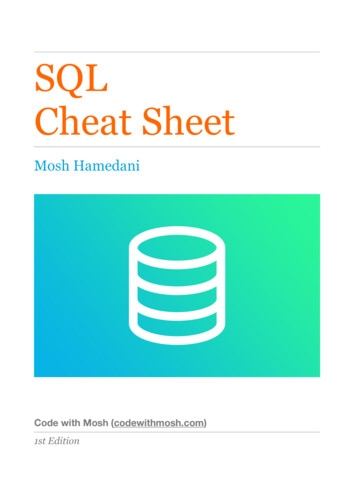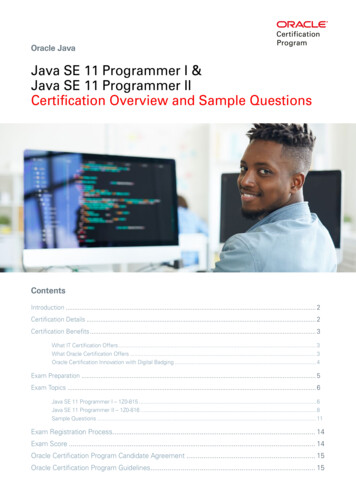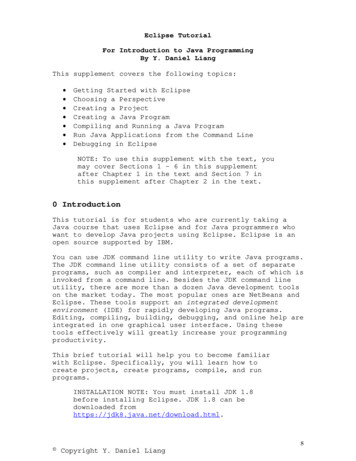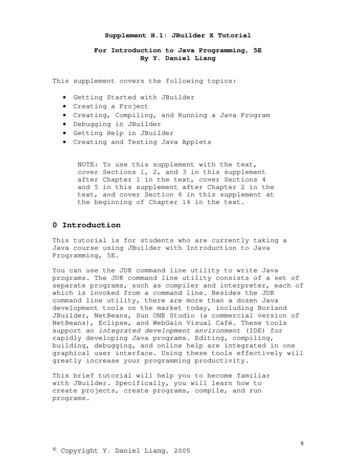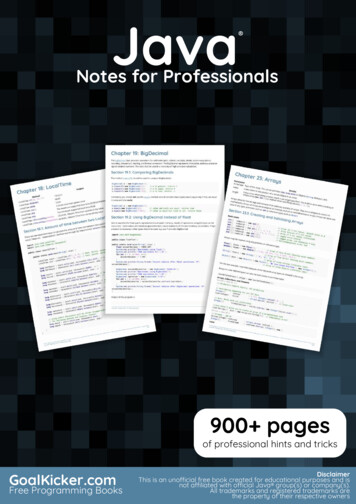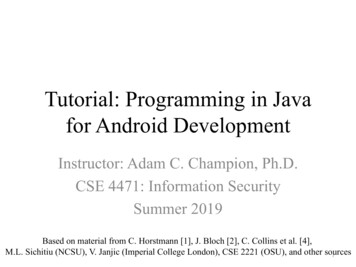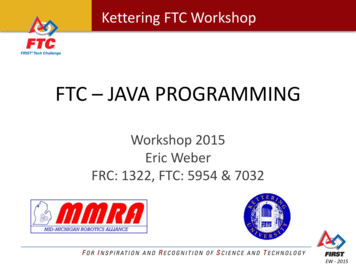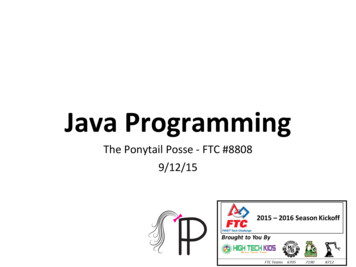
Transcription
JavaCheat SheetMosh HamedaniCode with Mosh (codewithmosh.com)1st Edition
About this Cheat SheetThis cheat sheet includes the materials I’ve covered in my Java tutorial forBeginners on my YouTube thmoshBoth the YouTube tutorial and this cheat cover the core language constructs andthey are not complete by any means.If you want to learn everything Java has to offer and become a Java expert, checkout my Ultimate Java Mastery te-java-mastery-series
About the AuthorHi! My name is Mosh Hamedani. I’m a software engineerwith two decades of experience and I’ve taught over threemillion people how to code or how to become a professionalsoftware engineer. It’s my mission to make softwareengineering simple and accessible to hhamedanihttps://facebook.com/programmingwithmosh/
Basics .6Java Development Kit .6Java Editions .6How Java Code Gets Executed . 6Architecture of Java Applications .65 Interesting Facts about Java . 7Types .8Variables. 8Primitive Types .8Declaring Variables .8Comments .9Reference Types. 9Strings .9Useful String Methods .9Escape Sequences . 10Arrays .10The Array Class .11Multi-dimensional Arrays .11Constants . 11Arithmetic Expressions . 11Order of Operations . 12Casting . 12Formatting Numbers. 13Reading Input .13Control Flow . 14Comparison Operators . 14Logical Operators .14If Statements .14The Ternary Operator .15Switch Statements.15
For Loops . 16While Loops .16Do.While Loops .16For-each Loops .16Want to Become a Java Expert? .18
BasicsJava is one of the most popular programming languages in the world. With Javayou can build various types of applications such as desktop, web, mobile apps anddistributed systems.Java Development KitWe use Java Development Kit (JDK) to build Java applications. JDK contains acompiler, the Java Runtime Environment (JRE) and a library of classes that we useto build applications.Java EditionsWe have four editions of Java, each used for building a different type ofapplication: Java Standard Edition (SE): the core Java platform. It contains all of thelibraries that every Java developer must learn. Java Enterprise Edition (EE): used for building very large scale,distributed systems. It’s built on top of Java SE and provides additionallibraries for building fault-tolerant, distributed, multi-tier software. Java Micro Edition (ME): a subset of Java SE, designed for mobiledevices. It also has libraries specific to mobile devices. Java Card: used in smart cards.How Java Code Gets ExecutedThe Java compiler takes Java code and compiles it down to Java Bytecode which isa cross-platform format. When we run Java applications, Java Virtual Machine(JVM) gets loaded in the memory. It takes our bytecode as the input and translatesit to the native code for the underlying operating system. There are variousimplementations of Java Virtual Machine for almost all operating systems.Architecture of Java Applications
The smallest building blocks in Java programs are methods (also called functionsin other programming languages). We combine related methods in classes, andrelated classes in packages. This modularity in Java allows us to break down largeprograms into smaller building blocks that are easier to understand and re-use.5 Interesting Facts about Java1. Java was developed by James Gosling in 1995 at Sun Microsystems (lateracquired by Oracle).2. It was initially called Oak. Later it was renamed to Green and was finallyrenamed to Java inspired by Java coffee.3. Java has close to 9 million developers worldwide.4. About 3 billion mobile phones run Java, as well as 125 million TV sets andevery Blu-Ray player.5. According to indeed.com, the average salary of a Java developer is just over 100,000 per year in the US.
TypesVariablesWe use variables to temporarily store data in computer’s memory. In Java, the typeof a variable should be specified at the time of declaration.In Java, we have two categories of types: Primitives: for storing simple values like numbers, strings and booleans. Reference Types: for storing complex objects like email messages.Primitive TypesTypeBytesRangebyte1 [-128, 127]short2 [-32K, 32K]int4 [-2B, 2B]long8float4double8char2 A, B, C, boolean1 true / falseDeclaring Variablesbyte age 30;long viewsCount 3 123 456L;float price 10.99F;char letter ‘A’;boolean isEligible true; In Java, we terminate statements with a semicolon.
We enclose characters with single quotes and strings (series of characters) withdouble quotes. The default integer type in Java is int. To represent a long value, we should add Lto it as a postfix. The default floating-point type in Java is double. To represent a float, we shouldappend F to it as a postfix.CommentsWe use comments to add notes to our code.// This is a comment and it won’t get executed.Reference TypesIn Java we have 8 primitive types. All the other types are reference types. Thesetypes don’t store the actual objects in memory. They store the reference (or theaddress of) an object in memory.To use reference types, we need to allocate memory using the new operator. Thememory gets automatically released when no longer used.Date now new Date();StringsStrings are reference types but we don’t need to use the new operator to allocatememory to them. We can declare string variables like the primitives since we usethem a lot.String name “Mosh”;Useful String MethodsThe String class in Java provides a number of useful methods: startsWith(“a”) endsWith(“a”) length()
indexOf(“a”) replace(“a”, “b”) toUpperCase() toLowerCase()Strings are immutable, which means once we initialize them, their value cannot bechanged. All methods that modify a string (like toUpperCase) return a new stringobject. The original string remains unaffected.Escape SequencesIf you need to use a backslash or a double quotation mark in a string, you need toprefix it with a backslash. This is called escaping.Common escape sequences: \\ \” \n (new line) \t (tab)ArraysWe use arrays to store a list of objects. We can store any type of object in an array(primitive or reference type). All items (also called elements) in an array have thesame type.// Creating and and initializing an array of 5 elementsint[] numbers new int[3];numbers[0] 10;numbers[1] 20;numbers[2] 30;// Shortcutint[] numbers { 10, 20, 30 };
Java arrays have a fixed length (size). You cannot add or remove new items onceyou instantiate an array. If you need to add new items or remove existing items,you need to use one of the collection classes.The Array ClassThe Array class provides a few useful methods for working with arrays.int[] numbers { 4, 2, 7 };Arrays.sort(numbers);String result );Multi-dimensional Arrays// Creating a 2x3 array (two rows, three columns)int[2][3] matrix new int[2][3];matrix[0][0] 10;// Shortcutint[2][3] matrix {{ 1, 2, 3 },{ 4, 5, 6 }};ConstantsConstants (also called final variables) have a fixed value. Once we set them, wecannot change them.final float INTEREST RATE 0.04;By convention, we use CAPITAL LETTERS to name constants. Multiple words canbe separated using an underscore.Arithmetic Expressionsint x 10 3;
int xint xint xfloatint x x 10 - 3;10 * 3;10 / 3;// returns an int (float)10 / (float)3; // returns a float10 % 3;// modulus (remainder of division)Increment and Decrement Operatorsint x 1;x ;// Equivalent to x x 1x--;// Equivalent to x x - 1Augmented Assignment Operatorint x 1;x 5; // Equivalent to x x 5Order of OperationsMultiplication and division operators have a higher order than addition andsubtraction. They get applied first. We can always change the order usingparentheses.int x 10 3 * 2;int x (10 3) * 2;// 16// 26CastingIn Java, we have two types of casting: Implicit: happens automatically when we store a value in a larger or moreprecise data type. Explicit: we do it manually.// Implicit casting happens because we try to store a short// value (2 bytes) in an int (4 bytes).short x 1;int y x;
// Explicit castingint x 1;short y (short) x;To convert a string to a number, we use one of the following methods: Byte.parseByte(“1”) Short.parseShort(“1”) Integer.parseInt(“1”) Long.parseLong(“1”) Float.parseFloat(“1.1”) Double.parseDouble(“1.1”)Formatting NumbersNumberFormat currency NumberFormat.getCurrencyInstance();String result currency.format(“123456”); // 123,456NumberFormat percent NumberFormat.getPercentInstance();String result percent(“0.04”); // 4%Reading InputScanner scanner new Scanner(system.in);double number scanner.nextDouble();byte number scanner.nextByte();String name scanner.next();String line scanner.nextLine();
Control FlowComparison OperatorsWe use comparison operators to compare values.xxxxxx y! y. y y y y// equality operator// in-equality operatorLogical OperatorsWe use logical operators to combine multiple boolean values/expressions. x && y (AND): if both x and y are true, the result will be true. x y (OR): if either x or y or both are true, the result will be true. !x (NOT): reverses a boolean value. True becomes false.boolboolboolboolhasHighIncome true;hasGoodCredit false;hasCriminalRecord false;isEligible (hasHighIncome hasGoodCredit) && !isEligible;If StatementsHere is the basic structure of an if statement. If you want to execute multiplestatements, you need to wrap them in curly braces.if (condition1)statement1else if (condition2)statement2else if (condition3)statement3
elsestatement4The Ternary OperatorString className (income 100 000) ? “First” : “Economy”;This is a shorthand to write the following code:String className;if (income 100 000)className “First”;elseclassName “Economy”;Switch StatementsWe use switch statements to execute different parts of the code depending on thevalue of a variable.switch (x) {case 1: break;case 2: break;default: }After each case clause, we use the break statements to jump out of the switchblock.
For LoopsFor loops are useful when we know ahead of time how many times we want torepeat something. We declare a loop variable (or loop counter) and in eachiteration we increment it until we reach the number of times we want to executesome code.for (int i 0; i 5; i )statementWhile LoopsWhile loops are useful when we don’t know ahead of time how many times we wantto repeat something. This may be dependent on the values at run-time (eg what theuser enters).while (someCondition) { if (someCondition)break;}We use the break statement to jump out of a loop.Do.While LoopsDo.While loops are very similar to while loops but they executed at least once. Incontrast, a while loop may never get executed if the condition is initially false.do { } while (someCondition);For-each LoopsFor-each loops are useful for iterating over an array or a collection.int[] numbers {1, 2, 3, 4};for (int number : numbers)
Want to Become a Ja
The Java compiler takes Java code and compiles it down to Java Bytecode which is a cross-platform format. When we run Java applications, Java Virtual Machine (JVM) gets loaded in the memory. It takes our bytecode as the input and translates it to the native code for the underlying operating system. There are various implementations of Java Virtual Machine for almost all operating systems.
